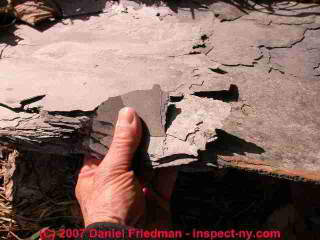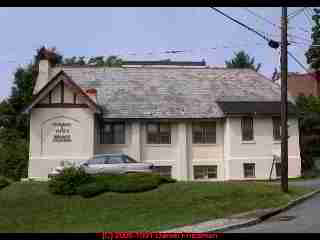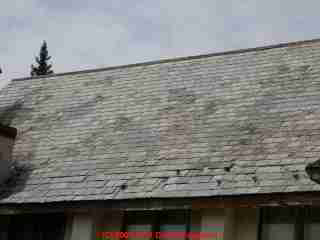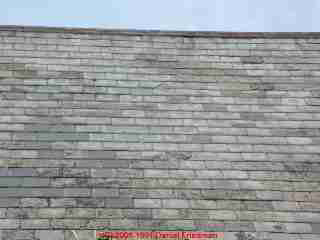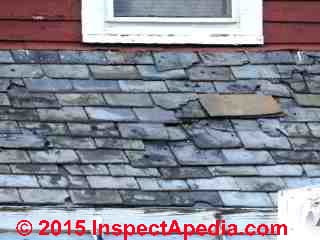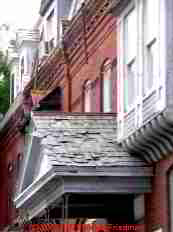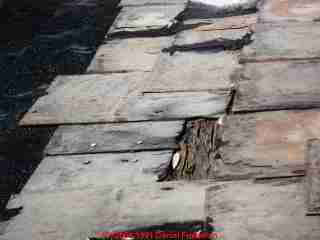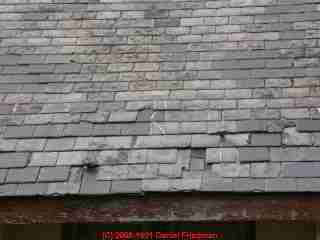 Photo Guide to Worn Out Slate Roofs
Photo Guide to Worn Out Slate Roofs
- POST a QUESTION or COMMENT about wear indicators on slate roofs - how do we conclude that a slate roof is worn out or is beyond economical repair?
Worn-out slate roof indicators:
How do we decide that the roof is beyond economical repair? Here we provide photos of worn-out slate roofs that are beyond repair. This slate roofing photo library shows various kinds of roofing slate, slate roof colors, slate roof patterns, and roofing slate defects.
This photographic dictionary of roofing slates is a supplement to our detailed article describing procedures for evaluating the condition of slate roofing. How to inspect, identify defects, and estimate remaining life of slate roofs are addressed. The article also references slate repair procedures, repair slate sources, and slate quarries. The main article reviews types of slate, common defects, inspection topics, and some repair tips.
InspectAPedia tolerates no conflicts of interest. We have no relationship with advertisers, products, or services discussed at this website.
- Daniel Friedman, Publisher/Editor/Author - See WHO ARE WE?
Photo Guide to Slate Roofs in Poor Condition or Worn Out
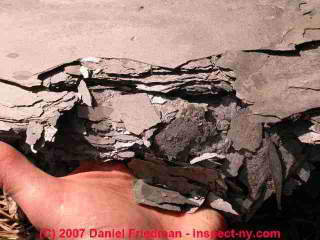 Roofing slates that are "rotted", soft, delaminated, worn out, crumbling, beyond repair
Roofing slates that are "rotted", soft, delaminated, worn out, crumbling, beyond repair
at a slate roof class organized by the author and conducted in New York in the 1980's a slate roofer referred to "rotted roofing" slates - which made sense to him but not to the rest of us.
[Click to enlarge any image]
Slate is essentially a complex mineral or stone product - so how could slate actually "rot".
Well it doesn't. Not quite anyway. (Though slate, as a naturally occurring mineral, can include soft inclusions, even organic debris, slate is basically stone. Minerals don't rot.)
But depending on their composition (each slate quarry has a unique chemical signature that identifies its slates), slates can become soft, crumbling, or delaminated that on touching a slate it is found to be completely softened and thus completely at or past the end of its life.
Below I illustrate this condition in three photographs.
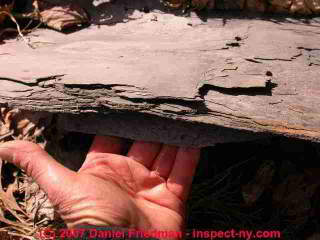
As we discussed in more detail at SLATE ROOF INSPECTION & REPAIR, determination of slate condition other than by direct up-close inspection is highly unreliable. Slates may look fine from the ground, but be found soft and at end of life on close inspection.
By direct inspection we mean looking at slates from a few inches, either from a ladder or some other point of view such as an attic window. We strongly advise inspectors not to walk on slate roofs whether they look soft or not.
Soft Deteriorated Roofing Slates may not be obvious from the ground but mean the roof is at end of life.
Rules of Thumb for Determining that a Slate Roof is "Worn Out" and not economically repairable
Here is a slate roof that is in poor condition, probably beyond repair.
What can we see that argues that the roof is at or past the end of its useful, reliable life and that it is beyond economical repair?
Even from a distance the home inspector or slate roof inspector can see that while many slates have been replaced (darker slates in the photo), the remaining roof slates show white mineral efflorescence which has formed almost all the way to the center of each slate.
The rust-colored slates in the photo were badly delaminated, thin, and soft, having no remaining predictable life. This slate roof is too fragile to inspect by walking-on.
For a closer look, check out the next two photos, below.
Because of the fragile nature of slate roofs, accessing the roof to perform repairs requires extra effort and care, and thus extra costs are involved. Most slate roofers opine that if more than twenty five percent of the slates on a roof are lost, damaged, broken, delaminated, or leaking, the roof is beyond economical "patching" and should be replaced.
In our experience, when we begin to work on a slate roof in the condition of the homes shown in these photos, invariably we find many more damaged slates than first met the eye, making that 25% number more credible than ever.
Examples of slate roofs in poor or worn-out condition
This poor condition slate roof sports many loose slates.
Eflorescence almost fills the upper slates, and there are many thin delaminating slates: more than 25% of this roof is bad, beyond economical repair.
Watch out: don't confuse superficial or light surface delamination that appears on the surface of roofing slates that remain in good condition with delamination that indicates that the whole slate is soft and shot.
It often requires an up-close look and probably some gentle "touching" or probing for a roofer or roof inspector to conclude with confidence that slates are in good condition with surface delamination versus in poor condition and worn out.
See DELAMINATING for clarification about delaminating roofing slates..
This point of confusion is another argument that a "roof inspection" performed only from the ground is, of necessity, incomplete.
At above is a poor condition slate roof - close up photograph of a roof beyond economical repair (using slate) - a patch and struggle policy may be tolerable.
The dark colored slates are areas where bad slates have been replaced.
We'd love to see this replacement pattern continue. Many roofers opine that when more than 25% of the slates have to be replaced in a short period, the roof is beyond economical repair..
Worn slates at or near end of life, in the upper roof (above): note the efflorescence on some slates and the delaminating slates.
Above is a slate roof in poor condition on a Poughkeepsie New York home.
We see numerous broken slates, slates with holes, delamiated thin slates, loose slates sliding down, a few temporary repair slates. Evidently the building owner agreed that this slate roof was at end of life. A few days after we took this photograph (April 2015) we observed a roofing crew installing a new roof covering on this building.
Some slates, such as the green or red slates shown in several photos above, do not show this efflorescence pattern, probably because the composition of that stone resists moisture absorption better than the darker slates shown in this photo.
Worn slates at end of life, lost slates, delaminated slates, broken slates on this small roof make re-roofing necessary
Worn out slates and sliding slates, on a slate roof beyond economical repair. Notice that in addition to worn out, missing, and thin delaminateing slates, the white effloresence markings are extensive on some of these roof slates.
Some slaters inform us that when they see the efflorescence marks on slates having nearly completely covered the slate they guess that the slate is near the end of its life.
Sliding-down slates, failed nails, and rotted roof sheathing (photo above) show that this roof has not been maintained for a decade or more. Thin delaminated slates are worn out.
This roof is already leaking and is covered by slates that include so many soft, loose, lost-fastener & broken, or missing roof slates over soft rotted roof decking (more visible from the attic side) that the roof is beyond repair.
Reader Question: durability of repaired slate roofs
8/26/2014 Karla said:
If the roof is repaired and maintained will it be a good roof? Or is it better to replace?
Reply:
A properly repaired slate roof is a superb and durable roof.
Certainly the roofer has to make an accurate assessment of the roof condition and to replace enough loose, damaged, or questionable slates such that the remaining life of the roof is not only long, but also such that additional frequent costly repairs are needed.
If too big a percentage of the existing slates are bad then repair is not economical and it's time for a new roof.
It is precisely that reasoning that leads a slate roofer to adivse that if too big a percentage of the existing slates are bad then repair is not economical and it's time for a new roof. O
pinions about the percentage will vary by roof size, type, and type of slates installed, but for North American slate roofs using American or Canadian slates, if more than about 25% of the slates on an existing roof need replacement, because of the labor cost of working carefully to remove and replace individual areas of bad slate, at that percentage it becomes more economical to replace the entire roof with new slate.
...
Reader Comments, Questions & Answers About The Article Above
Below you will find questions and answers previously posted on this page at its page bottom reader comment box.
Reader Q&A - also see RECOMMENDED ARTICLES & FAQs
On 2015-05-17 - by (mod) -
Red slates from New York are most likely from the Granville quarry. That may lead to a profile for that source.
It's true and interesting that the chemistry of every slate quarry is unique. With sufficient technical analysis it's possible to identify the quarry from which an individual slate was cut. We discuss that phenomenon in this article series and in the article references.
On 2015-05-17 by Tina Grubba
I am trying to find out the chemical composition of red slate from New York slate mines can you help
Question: who can repair a slate roof in Ontario
(Dec 13, 2012) David Duc said:
Is there someone in Brockville (southeastern Ontario) that inspects and repairs slate roofs
Reply:
David, see these sources
- Canadian roofing slate sold in Canada & in the U.S. by North Country Slate, 880 Milner Avenue Unit B Toronto, Ontario Canada M1B 5N7 Email: info@ncslate.com Tel: 1-800-975-2835
- Canadian roofing slate sold in Canada by Edco Products (quarry source not stated), EDCO Corporate Headquarters Administrative, IT and engineering questions. 8700 Excelsior Blvd. Hopkins, MN 55353 Phone: 952.938.6313 Toll Free: 800.333.2580 Email: sales@edcoproducts.com
- Grist Slate and Tile Roofing, Inc., 141 Kamloops Ave, Victoria, BC, V8Z 1W4 Canada; Ph: 250-727-3611; Fax: 250-727-3612; Contact Person: Korby Grist; Email
- North Country Slate, 880 Milner Ave, Unit B, Toronto, ON M1B 5N7; Contact: David Large; Ph 800-975-2835; Cell 416-587-6070; Fax: 416-724-2807; Email: info@ncslate.com.
More information is at SLATE ROOF SOURCES & TOOLS
...
Continue reading at SLATE ROOF REPAIRS, HISTORY OF or select a topic from the closely-related articles below, or see the complete ARTICLE INDEX.
Or see these
Recommended Articles
- SLATE ROOF DEFECTS
- SLATE ROOF LEAKS
- SLATE ROOF INSPECTION & REPAIR - home
Suggested citation for this web page
SLATE ROOF REPAIR, WORN OUT at InspectApedia.com - online encyclopedia of building & environmental inspection, testing, diagnosis, repair, & problem prevention advice.
Or see this
INDEX to RELATED ARTICLES: ARTICLE INDEX to BUILDING ROOFING
Or use the SEARCH BOX found below to Ask a Question or Search InspectApedia
Ask a Question or Search InspectApedia
Try the search box just below, or if you prefer, post a question or comment in the Comments box below and we will respond promptly.
Search the InspectApedia website
Note: appearance of your Comment below may be delayed: if your comment contains an image, photograph, web link, or text that looks to the software as if it might be a web link, your posting will appear after it has been approved by a moderator. Apologies for the delay.
Only one image can be added per comment but you can post as many comments, and therefore images, as you like.
You will not receive a notification when a response to your question has been posted.
Please bookmark this page to make it easy for you to check back for our response.
IF above you see "Comment Form is loading comments..." then COMMENT BOX - countable.ca / bawkbox.com IS NOT WORKING.
In any case you are welcome to send an email directly to us at InspectApedia.com at editor@inspectApedia.com
We'll reply to you directly. Please help us help you by noting, in your email, the URL of the InspectApedia page where you wanted to comment.
Citations & References
In addition to any citations in the article above, a full list is available on request.
- Mark Cramer Inspection Services Mark Cramer, Tampa Florida, Mr. Cramer is a past president of ASHI, the American Society of Home Inspectors and is a Florida home inspector and home inspection educator. Mr. Cramer serves on the ASHI Home Inspection Standards. Contact Mark Cramer at: 727-595-4211 mark@BestTampaInspector.com
- John Cranor [Website: /www.house-whisperer.com ] is an ASHI member and a home inspector (The House Whisperer) is located in Glen Allen, VA 23060. He is also a contributor to InspectApedia.com in several technical areas such as plumbing and appliances (dryer vents). Contact Mr. Cranor at 804-873-8534 or by Email: johncranor@verizon.net
- Architectural elements: the technological revolution: Galvanized iron roof plates and corrugated sheets; cast iron facades, columns, door and window caps, ... (American historical catalog collection), Diana S Waite, available used out of Amazon.
- Building Pathology, Deterioration, Diagnostics, and Intervention, Samuel Y. Harris, P.E., AIA, Esq., ISBN 0-471-33172-4, John Wiley & Sons, 2001 [General building science-DF] ISBN-10: 0471331724 ISBN-13: 978-0471331728
- Building Pathology: Principles and Practice, David Watt, Wiley-Blackwell; 2 edition (March 7, 2008) ISBN-10: 1405161035 ISBN-13: 978-1405161039
- Handbook of Building Crafts in Conservation, Jack Bower, Ed., Van Nostrand Reinhold Company, NY 1981 ISBN 0-442-2135-3 Library of Congress Catalog Card Nr. 81-50643.
- Historic Preservation Technology: A Primer, Robert A. Young, Wiley (March 21, 2008) ISBN-10: 0471788368 ISBN-13: 978-0471788362
- Historic Slate Roofs : With How-to Info and Specifications, Tina Skinner (Ed), Schiffer Publishing, 2008, ISBN-10: 0764330012 , ISBN-13: 978-0764330018
- Low Slope Roofing, Manual of, 4th Ed., C.W. Griffin, Richard Fricklas, McGraw-Hill Professional; 4 edition, 2006, ISBN-10: 007145828X, ISBN-13: 978-0071458283
- Roof failure causes in depth (and specific methods for avoiding them)
- Slate Roofs, National Slate Association, 1926, reprinted 1977 by Vermont Structural Slate Co., Inc., Fair Haven, VT 05743, 802-265-4933/34.
- Roof Tiling & Slating, a Practical Guide, Kevin Taylor, Crowood Press (2008), ISBN 978-1847970237
- The Slate Roof Bible, Joseph Jenkins, www.jenkinsslate.com, 143 Forest Lane, PO Box 607, Grove City, PA 16127 - 866-641-7141 (We recommend this book).
- In addition to citations & references found in this article, see the research citations given at the end of the related articles found at our suggested
CONTINUE READING or RECOMMENDED ARTICLES.
- Carson, Dunlop & Associates Ltd., 120 Carlton Street Suite 407, Toronto ON M5A 4K2. Tel: (416) 964-9415 1-800-268-7070 Email: info@carsondunlop.com. Alan Carson is a past president of ASHI, the American Society of Home Inspectors.
Thanks to Alan Carson and Bob Dunlop, for permission for InspectAPedia to use text excerpts from The HOME REFERENCE BOOK - the Encyclopedia of Homes and to use illustrations from The ILLUSTRATED HOME .
Carson Dunlop Associates provides extensive home inspection education and report writing material. In gratitude we provide links to tsome Carson Dunlop Associates products and services.


